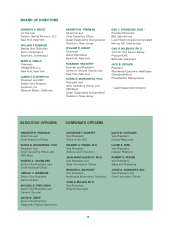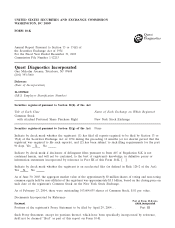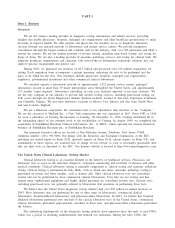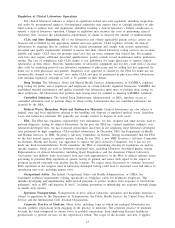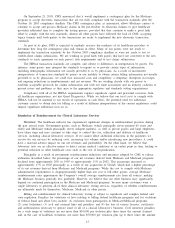Quest Diagnostics 2003 Annual Report Download - page 25
Download and view the complete annual report
Please find page 25 of the 2003 Quest Diagnostics annual report below. You can navigate through the pages in the report by either clicking on the pages listed below, or by using the keyword search tool below to find specific information within the annual report.out, are charged on a fee-for-service basis. We work closely with health insurers as they evaluate new tests;
however, as innovation in the testing area increases, there is no guarantee that health insurers will agree to
carve out these services or reimburse them at rates that reflect the true cost or value associated with such
services.
In recent years, there has been a shift in the way major insurers contract with clinical laboratories. Health
insurers have begun to offer more freedom of choice to their affiliated physicians, including greater freedom to
determine which laboratory to use and which tests to order. Accordingly, most of our agreements with major
health insurers are non-exclusive contracts. As a result, under these non-exclusive arrangements, physicians have
more freedom of choice in selecting laboratories, and laboratories are likely to compete more on the basis of
service and quality rather than price alone. Also, health insurers have been giving patients greater freedom of
choice and patients have increasingly been selecting plans (such as preferred provider organizations and
consumer driven plans) that offer a greater choice of providers. Pricing for these preferred provider
organizations is typically negotiated on a fee-for-service basis, which generally results in higher revenue per
requisition than under a capitated fee arrangement. Despite these trends, health insurers continue to aggressively
seek cost reductions in order to keep their premiums to their customers competitive. If we are unable to agree
on pricing with a health insurer, we would become a “non-participating’’ provider and could then only bill the
ordering physician or the patient rather than the health insurer. This “non-participating’’ status could lead to loss
of business since the physician is likely to refer testing to a participating provider whose testing is covered by
the patient’s health insurance benefit plan. We cannot assure investors that we will continue to be successful in
negotiating contracts with major insurers. Loss of multiple major insurer or other payer agreements could have a
material adverse effect on our financial condition, results of operations and cash flows.
We offer QuestNetTM, an innovative product to develop and manage a customized network of clinical
laboratory providers for health insurers. Through QuestNetTM, physicians and members are provided multiple
choices for clinical laboratory testing while health insurers realize cost reductions under a single capitated
arrangement.
Hospitals
We provide services to hospitals throughout the United States that vary from esoteric testing to helping
manage their laboratories. We believe that we are the industry’s market leader in servicing hospitals. Our
hospital customers account for approximately 13% of our net revenues, the majority of which represents
services billed to the hospitals under reference testing arrangements, based on negotiated fee schedules, for
certain testing that the hospitals do not perform internally. Hospitals generally maintain an on-site laboratory to
perform testing on patients and refer less frequently needed and highly specialized procedures to outside
laboratories, which typically charge the hospitals on a negotiated fee-for-service basis. We believe that most
hospital laboratories perform approximately 90% to 95% of their patients’ clinical laboratory tests. In addition,
many hospitals compete with commercial clinical laboratories for outreach (non-hospital patients) testing. Most
physicians have admitting privileges or other relationships with hospitals as part of their medical practice. Many
hospitals leverage their relationships with community physicians and encourage the physicians to send their
outreach testing to the hospital’s laboratory. In addition, hospitals that own physician practices generally require
the physicians to refer tests to the hospital’s affiliated laboratory. As a result, hospital-affiliated laboratories can
be both customers and competitors for commercial clinical laboratories.
During 2002, in conjunction with the acquisition of AML, we launched dedicated sales and service teams
focused on serving the unique needs of hospital customers. We believe that the combination of full-service, bi-
coastal esoteric testing capabilities, medical and scientific professionals for consultation, innovative connectivity
products, focus on Six Sigma quality and dedicated sales and service professionals has positioned us to be a
partner of choice for hospital customers.
We have joint venture arrangements with leading integrated health delivery networks in several metropolitan
areas. These joint venture arrangements, which provide testing for affiliated hospitals as well as for unaffiliated
physicians and other healthcare providers in their geographic areas, serve as our principal laboratory facilities in
their service areas. Typically, we have either a majority ownership interest in, or day-to-day management
responsibilities for, our hospital joint venture relationships. We also manage the laboratories at a number of
other hospitals.
8



